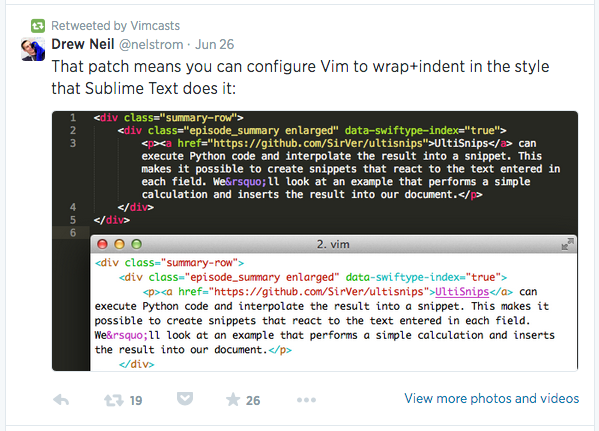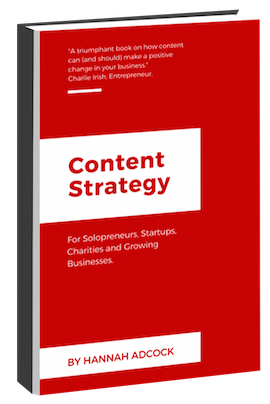Earlier this year I worked with Drew Neil on the Vimcasts redesign. We had three main goals: to increase engagement with the website by making the content easier to navigate on all devices, to increase traffic through a broader social media strategy and to give more visibility to training, publications and pro-screencasts. So, did we achieve our goals? In this post I compare data from before and after the launch.
###Goal 1. Increase engagement with the website by making the content easier to navigate on all devices.
What we did:
- added search
- added a categories page
- switched from a rails-based CMS to a static site generator to reduce page load time
- gave the homepage a cleaner look so people can easily view the latest blog posts, screencast or do a general search for what interests them most
- made the website responsive
- added more metadata to screencasts so viewers could make an informed decision about when and how to watch them
- added related content to screencast and article pages
- categorised all screencasts and articles to make it easier to find similar content
Here’s what happened:
####The audience engaged more with the website There was a noticeable increase in the number of pages that visitors browsed in one session as well as the time they spent on site. Despite a slight decrease in overall site visitors, the total number of pages visited increased from 168,100 in the three months preceding the launch to 199,000 pageviews in the three months afterwards. We saw an increase from 1.99 to 2.48 pages/session, while average session duration went up from 2m59s to 3m23s. Looking at Google Analytics’ behavior flow we saw more people interacting once and then twice with the website and fewer drops offs.

This increase in engagement was apparent on all devices. For mobile users, we saw an increase from 1.95 to 2.34 pages/session; for tablet users, we saw an increase from 2.52 to 3.17 pages/session. The site-wide bounce rate for mobile users also slightly decreased from 71% to 67.6% and for tablet users from 62% to 58%.
####Potential Vimcast fans slightly preferred the new homepage The homepage bounce rate dropped from 49% to 43% – still plenty of room for improvement, but a move in the right direction. The exit rate dropped from 42.98% to 35.65%. The number of pages/session also increased to 4.08 from 2.82 and the avg. session duration increased to a respectable 6.10sec from 4.51sec.
####The site speed increased The average page load time decreased from 7.65secs to 3.68secs.
####My thoughts The data is encouraging: there has been a measurable increase in engagement with the website on all devices. There is still room for improvement though. There is too little prioritisation of content on the homepage, meaning that some visitors are unsure what action to take.
Also, are there other factors that could explain these results? I considered whether people were confused by the new website and clicked through to find what they wanted. I also considered whether visitors landed on the homepage rather than the deprioritised archive page and clicked through the site to find relevant content. However, these suggestions are a bit pessimistic. To continue moving through a site people usually need to have faith that they’ll find the information they need. Confused visitors tend to leave. We also actually saw a decrease in the number of visitors landing on the hompepage (28.85% to 23.55%) – more visitors were landing directly on screencast or article pages and then moving around the site.
###Goal 2. Increase traffic through a broader social media strategy
What we did:
- added share buttons to screencast and article pages
- set up a Google+ account for Vimcasts
What we failed to do:
- set up a Facebook account – there had been some Vimcasts references on Facebook
- use more images on social media
- draw up a proper social media strategy
Here’s what happened:
Not a lot. The Google+ account is slowly gaining traction (720 views) and people are sharing and liking the posts. Twitter remains a popular way for people to engage with Vimcasts – there are currently 3,900 followers, which is 400 more than at the end of January. However, the number of people finding Vimcasts though social media has remained fairly constant.
####My thoughts We’ve probably got the results we deserve in terms of this goal. The share buttons are not being used much. This might be because they are at the end of screencast (and article) pages and only some people will see them. It might also be because they are just above related content meaning visitors are presented with two possible actions - and choose the latter. A possible solution is to move the share buttons to the top (or side) of the article and screencast pages.
We also need to draw up a sustainable social media strategy. Drew has been working on a new business idea so it’s not been easy for him to run several projects at the same time. Interestingly, a recent post with an image that Drew retweeted from his personal account did very well with 26 stars and 19 retweets. Perhaps we should consider using more images to advertise posts? It’s easy for text and link only posts to go unnoticed in people’s busy timelines.

I’m not convinced it’s worth setting up a Facebook account. With limited resources we should probably concentrate on the two channels that our tech-savvy crowd tend to prefer. Google+ hasn’t proven it’s value yet, but I wonder if publishing there might help our search rankings. Certainly, our organic search traffic is up slightly, although this could just be because the site architecture and metadata is better. I’m not sure: best practice for search engine optimisation seems to change so quickly and opaquely.
###Goal 3. Give more visibility to training, publications and pro-screencasts
What we did
- added permanent links on the homepage
- added training category to main navigation
- redesigned existing landing pages and added new ones
- added a banner at the top of key pages that could be used to advertise the latest paid product
Here’s what happened:
It’s slightly hard to be measure because Drew has been promoting his Core Vim Course, a new product. He hasn’t scheduled any Core Vim classes. So, numbers are down in terms of people looking at the Core Vim Class landing page – understandably, because you can’t book one. However, the bounce rate for this redesigned page is down 8% and people are staying on the site for an average of 2.65 pages/sessions after entering on this page. Perhaps they see enough to make them want to stick around. The Core Vim Course has also done better than Drew expected and Drew’s book Practical Vim continues to sell well.

####My thoughts There’s still room for improvement in terms of the homepage and in terms of optimising key landing pages. At the moment, people can’t use PayPal to buy the Core Vim Course and Classes. This is affecting the conversion rate, among other factors.
To gain a better understanding of how people interact with the paid options on the website, I need to track people through the sales funnel more effectively. This is something I’ll be looking at in the near future.
###Need help working out how you can improve your digital content? Get in touch! Or you can find out more about how content strategy can help your business.
Content Strategy for Solopreneurs, Startups, Charities and Growing Businesses
This book will help you tackle 12 common business challenges including making sure you're reaching everyone who could be a customer, persuading people to buy from you and not a competitor, and how you can get your team to produce useful usable content. Read more about the ebook.
You'll learn
- How thinking strategically about your content will drive growth
- Practical tips on creating content strategy deliverables that will save you time and money
- How to create a content strategy for your company in 4 weeks
